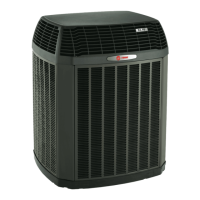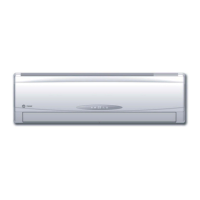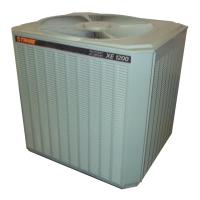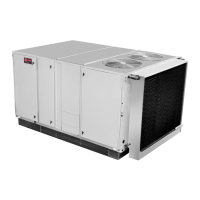Installation
OAU-SVX005C-EN 19
Main Electrical Power Requirements
Note: All field-installed wiring must comply with NEC
and applicable local codes.
Condensate Drain Configuration
OAU units are selected based on dehumidification
capability. As such, condensate can form at a high rate.
Therefore, the OAU drain pan and condensate line are
sized and designed accordingly. However, an often-
overlooked element of proper condensate drainage is
proper P-Trap and drain line sizing and installation. An
incorrectly-designed and -installed P-Trap can restrict
condensate flow or cause water in the condensate drain
pan to “spit” or “geyser” which may cause condensate
overflow. Carefully install and trap the drain pan to ensure
adequate condensate removal under all conditions.
An evaporator condensate drain connection is provided
on the unit. Refer to Figure 11, p. 20 for the drain location.
A condensate trap must be installed at the unit due to the
drain connection being on the “negative pressure” side of
the fan. Install the P-Trap using the guidelines in Figure 9.
Pitch drain lines connected to P-Trap at least 1/2 inch for
every 10 feet of horizontal run to assure proper
condensate flow. Do not allow the horizontal run to sag
causing a possible double-trap condition which could
result in condensate backup due to “air lock”.
Filter Installation
Each unit ships with 2-inch permanent filters (mist
eliminators) along with the specified MERV-rated pleated
filters installed in the air inlet hood. The quantity of filters
is determined by unit size. Access to the filters is through
the hinged filter access panel on the air intake hood. Filter
type, size, and quantity are determined by selected filter
option and unit size.
Note: Do not operate the unit without filters. Pleated
filters are installed in the inlet hood in the direct-
fired unit.
Set the unit onto the curb; check for level.
Ensure unit-to-curb seal is tight and without buckles
or cracks.
Install and connect proper condensate drain line to
the evaporator condensate pan drain connection (see
Figure 9, p. 19).
Verify that the power supply complies with the unit
nameplate specifications.
Inspect all control panel components; tighten any
loose connections.
Connect properly sized and protected power supply
wiring to a field-supplied/-installed disconnect switch
and to the main power terminal block (HTB1) in the
unit control panel.
Connect properly-sized earth ground.
Figure 9. Condensate trap installation
D = Pipe diameter (1 in.)
H = Internal static pressure (in wg) +1 in.
J = H x 0.5
L = H + J +D
Notes:
1. Pitch drain at least 1/2 in. per 10 ft horizontal run.
2. Condensate drain pan will not drain properly if P-trap is not primed
and of adequate height to allow for cabinet operating negative
pressure.
WARNING
Do Not Install Filters or Flammable
Components Downstream of Direct-Fired
Burner!
Installing filters or flammable components downstream
of the direct-fired burner could cause a fire hazard and
result in death or serious injury.
AVERTISSEMENT
N’installez pas de filtre ou de composant
inflammable en aval du brûleur à feu
direct!
L’installation de filtres ou de composants inflammables
en aval du brûleur à feu direct peut provoquer un risque
d’incendie et résulter en des blessures graves, voire
mortelles..
D" NPT FEMALE
CONNECTOR
CLEANOUT PLUG
D = PIPE DIAMETER
H = INTERNAL STATIC PRESSURE (IN W.G.) + 1"
J = H * 0.5
L = H + J + D

